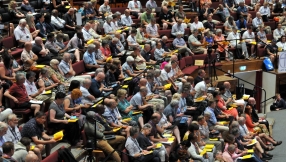The cloth believed by millions to have been wrapped around Jesus' body after the crucifixion is a fake, a British scholar has claimed.
In an article for the History Today journal, Charles Freeman claims that it is likely that the Turin Shroud was used in a medieval ceremony that took place early on Easter Sunday; the Quem Querritis, 'Whom do you seek?'
"One of the most important features of the ceremony was the display of the cloth," Freeman writes. During various performances, it is thought that it would have been used in depictions of the empty tomb after Jesus has risen.
"No one has found any significant evidence of the Shroud's existence before 1355, when it appeared in a chapel at Lirey, in the diocese of Troyes, supposedly advertised there as the burial shroud of Christ," Freeman adds.
According to the scholar, the Shroud – famed for holding the imprint of a crucified man with long hair and a bearded face – will have originally have displayed "much more prominent" images.
"The Shroud would not have made an impact on such large crowds if they had not been. There are features – the Crown of Thorns, the long hair on Christ's neck, the space between the elbows and the body, the loincloth – that can no longer be seen today," Freeman explains.
"Astonishingly, few researchers appear to have grasped that the Shroud looked very different in the 16th and 17th centuries".
There are a number of theories supporting the Shroud's authenticity. Researchers at the Politecnico di Torino this year claimed that a powerful earthquake in Jerusalem in AD 33 could have skewed radiocarbon dating results and made the cloth seem younger than it truly is.
In 2011, another group of Italian scientists, this time from the National Agency for New Technologies, Energy and Sustainable Development, claimed that the relic could not have been forged using technologies available in medieval times.
Freeman, however, contends that much of the speculation surrounding the Shroud is "absurd".
Nonetheless, the venerated cloth is expected to draw a crowd of two million when it goes on display in Turin next year.













